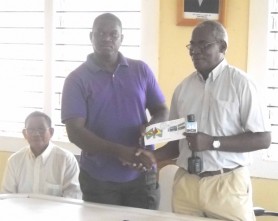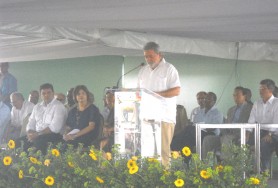Lula: Brazil to explore funding for paving Lethem/Linden road
In the midst of a torrential downpour of rain, President Bharrat Jagdeo and his Brazilian counterpart Luiz Inacio Lula da Silva yesterday cut the ribbon on the Takutu Bridge, officially commissioning the much-anticipated linkage between Guyana and Brazil.

Shortly after the conclusion of the opening ceremony in Bon Fim, the weather threatened the symbolic cutting of the ribbon but both leaders exited their vehicles in the pouring rain and emerged sharing an umbrella in what seemed to be a deliberate attempt to demonstrate unity. Minutes earlier, both presidents had pledged to work closely together towards fostering closer ties between both countries.
During the opening ceremony, President Lula declared the opening of the long-in-the-works bridge to be the achievement of a dream that was thirty years old and said it “is the first physical link between two countries which for so long have turned their backs to each other.” He said that it would foster greater collaboration between the two territories and announced that the Brazilian government was coming on board to support Guyana with other initiatives.
Lula announced that the paving of Lethem to Linden highway would be the next challenge. This announcement was met with a loud applause by the capacity audience, which drew citizens from both countries.
Lula announced that a Brazilian Technical Mission will be in Georgetown at the end of this month to study the financial conditions for the project. Once completed, there would be a full land link between Boa Vista and Georgetown expanding prospects to Guyana and the entire northern region of Brazil, Lula noted.

The Brazilian President also announced his country’s commitment to the construction of the much talked about 800 megawatts hydropower plant in Guyana. He announced that Brazilian officials will be visiting Georgetown in October to talk about this project. Lula, while emphasizing the importance of energy and electric power in carrying out all the potential for investment and cooperation between the two countries, said that he was “ready to have Brazilian companies finance the construction of hydropower plants in Guyana.” He said that this initiative would also benefit the Brazilian state of Roraima.
Lula noted that the bridge has already had its benefits for both countries, citing immediate benefits to frontier communities that were traditionally forgotten. Meanwhile, he announced that agriculture will be one of the avenues of investment that the country will be pursuing in Guyana. He stated that this was an opportunity for Brazilians to repeat their technological success in soya beans and rice in Guyana’s land. President Jagdeo is expected to meet Brazilian farmers in Boa Vista today.
He also called for the reduction in the imbalance of trade relations between the two countries, pointing out that the new bridge would help in the export of Guyanese products to Brazil. Lula said the bridge would also lead to a greater networking with Caricom and the rest of the region. “This bridge will also take Brazil to the Caribbean,” he declared. “I’m convinced that there will be no South American or even Latin American integration without the strong presence of the Caribbean,” he added. He noted that that is why Brazil recently joined the Caribbean Development Bank as a regional member. He also said that in 2010, the country will host the first Brazil/Caricom Summit.
Lula said too that the bridge would ensure that Guyana is fully incorporated into the network of South American nations.

Meanwhile, President Jagdeo emphasized that the bridge is an opportunity to improve trade and economic relations between the two countries, noting that trade has been relatively small despite the geographical proximity of the two countries. According to him, in 2004 trade between the two countries amounted to a modest US$9.7 million; most of which came from Brazilian imports. He said that this had almost doubled to about US$17.8 million in 2008.
Jagdeo also said inequality of the trade between Brazil and other Caricom territories was also disappointing. According to him, Caricom imports from Brazil have increased from US$744 million in 2004 to $1.2 billion in 2007. He said that despite this, exports by Caricom territories to Brazil have moved from US$38 million in 2004 to US$91 million in 2007. He, however, expressed the hope that this will change with the new link. He pointed out that the new bridge will help Guyana to trade more items under the Guyana/Brazil partial scope agreement, which he said Guyana has not benefited from fully as yet. The Takutu Bridge provides Caricom goods and services providers access to one of the top ten economies of the world, Jagdeo pointed out.
Jagdeo was high in praise for President Lula and his government for the support they had given to the project. He also expressed gratitude to the Brazilians for the help they were offering to other major projects the country was undertaking. He said that as both countries worked together both nations stood to benefit.
He identified several areas for partnership, including the development of ICTs through fibre optic cables, and the filling of critical gaps in air transport.
Meanwhile, Regional Chairman of Region Nine (Upper Takutu/Upper Essequibo) Clarindo Lucas in a brief address noted the positive implications for both territories. He said the introduction of several special regimes will encourage the movement of goods and transportation, while there is also the potential for economic growth and the potential for tourism.
This will also encourage cultural mixing, he said.
Foreign Minister Carolyn Rodrigues-Birkett signed a Memorandum of Understanding with her counterparts from Brazil, touching on issues related to Defence Cooperation (cooperation in sharing intelligence), promotion of Trade and Investment, Control of the Carambola fruit fly, Geological Mapping on both sides of borders, the establishment of a Frontiers Committee, the establishment of Special Regimes in the region and cultural cooperation.
The long-awaited bridge was opened to traffic in July, after a controversial informal opening in April by the governor of the Brazilian state of Roraima. Several prominent Guyanese from Lethem had attended but the ceremony had not been sanctioned by Guyana.
Barrels were eventually placed on the Guyana side to thwart traffic from Brazil. Construction was completed several months ago, years after construction had started. It had encountered several snags.
In April 2007, construction resumed on the bridge, six years after work had ceased owing to financial irregularities and after an initial start-up. In February 2005, Lula had made a pledge in Guyana’s parliament to have the bridge completed by the end of the same year.
During Lula’s visit he had said he was very aware of the importance of the bridge for Guyana and the northern states of Brazil, particularly the land-locked state of Roraima and he had indicated that he would visit Guyana for the commissioning of the bridge linking the two countries across the Takutu River.
After the financial irregularity was sorted out, the Brazilian National Congress in 2006 approved the sum of US$3 million (Rs$6 billion) to the Brazilian Ministry of Transportation to resume work on the bridge. However, it was not until April 2007 that actual work on the bridge resumed.
Apart from the importance of the bridge for trade in goods and services, including rice and sugar with Brazil, it is widely expected that the link would provide a much needed service to, and give seaport access to the landlocked state of Roraima. The bridge and route will also facilitate tourism and travel between the two countries.





